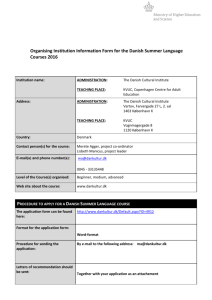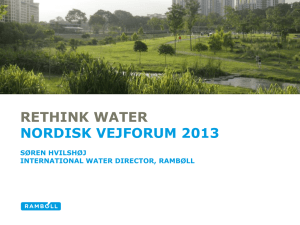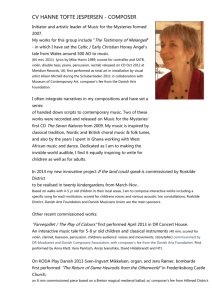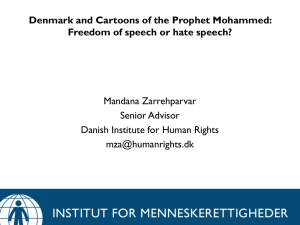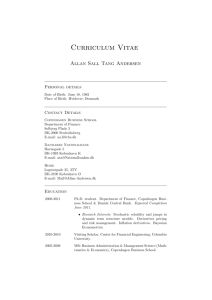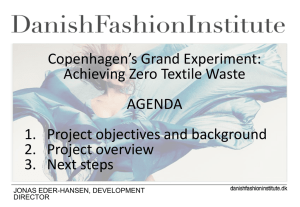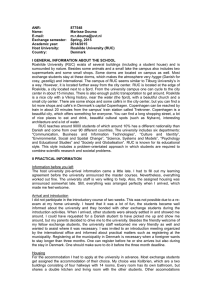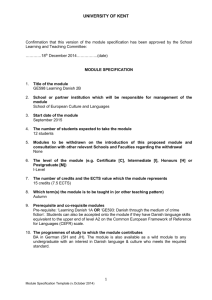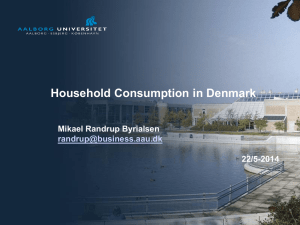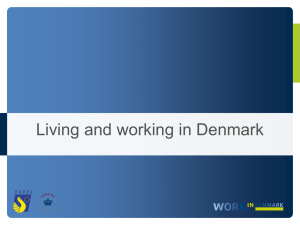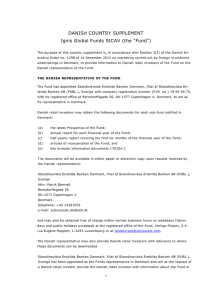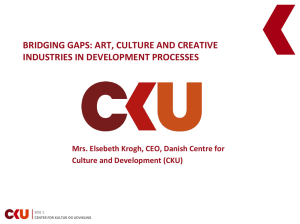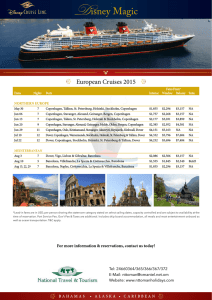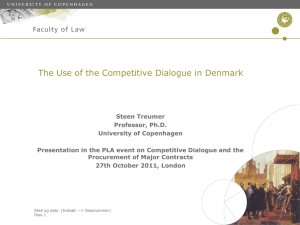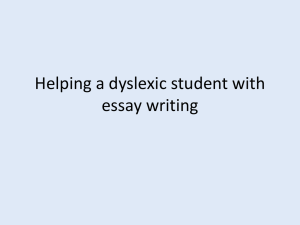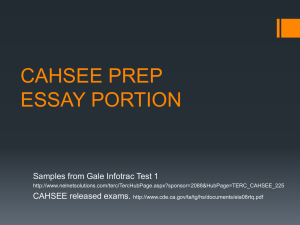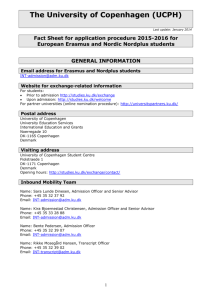Curriculum Reform: A Scandinavian Approach
advertisement
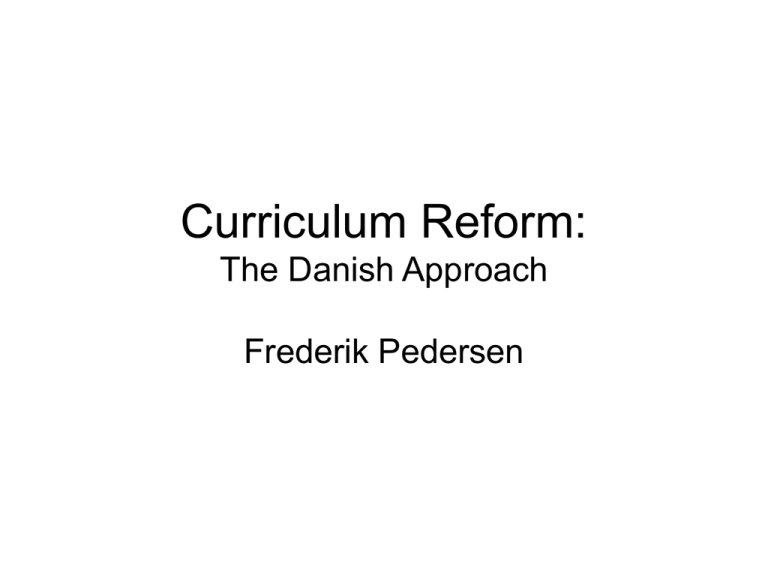
Curriculum Reform: The Danish Approach Frederik Pedersen Danish Tertiary Education Universities – Copenhagen (1479) – Århus (1928) – Odense (1964) • University Centres – Roskilde Universitetscenter (1972) – Ålborg Universitetscenter (1974). • Having amalgamated with SBI (”The State Building Research Institute”) known as Ålborg University since 1998 Main points of the Danish system • A prominent feature of Danish university education is the high level of student involvement in the planning of individual curricula and the focus on individual performance. – The course coordinator will normally hand out a suggested reading list, but students are encouraged to submit individual reading lists for each exam. • These reading lists meet certain objective criteria regarding length and composition and are individually examined and signed off by a member of faculty (who normally also will set the exam question). – E.g. Both History and English require a minimum of 1200 pages to be read (only allowing 200 pages for a monograph). Roskilde Universtetscenter • A radical departure for its time – Based on the concept of Broad Interdisciplinarity, problem/project-oriented teaching, team work, and group (rather than individual) evaluation. • The Centre was controversial among politicians in the seventies and eighties. Among the criticisms raised was the Location (the Social Democrats wanted a university in Ålborg), its modus operandi, its scientific level and its left-wing politics. Roskilde Universitetscenter • All students take a two-year Basis-uddannelse (foundation-course). – There are three of these: Science, Social Science, and Humanities – Half of the students’ first two years of study is taken up with Problem-oriented projects and the writing of joint papers in these projects. Oral exams are used to grade individual candidates • For more information in English see http://www.ruc.dk/humbas_en/. An English version of the text of the legislation covering the curriculum is on http://www.ruc.dk/humbas_en/doc/ • Information on the Sciences is on http://www.ruc.dk/ruc_en/studying/list/bsc/ Ålborg University (Centre) • Ålborg University focuses on interdisciplinary, inter-faculty studies – an experimental curriculum based on an interdisciplinary basic course with later specialization; – a pedagogical structure based on problem-centred, real-life projects of educational and research relevance - which internationally has become known and recognized as The Aalborg Experiment or The Aalborg Model. • With the problem-based, project-organized model, a great part of a semester’s teaching and student work revolves around complex “real-life” problems which the students analyse and investigate. Most of these projects are executed by groups of students and examined in these groups who all share the same mark for their performance. A Sample Curriculum • The following three slides outline the History curriculum for Copenhagen University – I have chosen Copenhagen because it is the the most traditional and conservative Danish university in terms of its curriculum. • However, the history Curriculum allows students to compose their own curriculum within well-defined boundaries and to conduct interdisciplinary research from their second year. • Copenhagen also maintains a strong quality control in core elements of the curriculum by allowing multiple resits of all courses (but the core Methodology course in particular). • An absolute standard (not a ”bell-curve”) is imposed in the Methodology course. – Although the introduction of an ”absolute standard” may initially discourage students, the Experiance of the Medieval Centre in Toronto shows that such a bar eventually (within five-ten years) attracts highquality students Copenhagen University • An example: History Curriculum – 1st year: • Introduction to literature and information gathering (12.5 %) – Evaluation: ”small asssignments” in three subjects • Introduction to Danish History (25 %) – Duration: 3 hours of seminars per week for two terms – Reading: a set of compulsory texts is provided by the course convener – Evaluation: three 5-6 page essays and an oral presentation or a written 6 hour exam with study aids. The Student answers 3 out of 5 essay questions composed by the internal examiner. • Introduction to World History (25 %) – Duration: 3 hours of seminars per week for two terms – Reading: a set of compulsory texts is provided by the course convener – Evaluation: as above. • Special area subject I (37.5 %): Danish or World History – Duration: 4 hours of seminars per week for two terms – Reading: 1200 pages read, 1/3 introductory texts, 2/3 focussed on two individual problems. Reading may be reduced by work in lieu (oral presentation or practice essay: this is left to the discretion of the coordinator) – Evaluation: 6 hour written exam or 30-minute oral exam » The student may be choose 1-hour preparation for the oral exam in which case the student must give a fifteen minute presentation to be followed by 10 minute discussion. ”Un-prepared” students are examined on the basis of a 30-minute dialogue with the examiner. Copenhagen University • An example: History Curriculum – 2nd year: • Historical method (25 %) – Duration: 4 hours a week for two terms – Evaluation: 48 hours before the exam the candidate is gven a dossier of 25-30 pages of original historical sources (including non-written sources). In addition, these texts have a written introduction and scholarly aparatus. The candidate answers one essay question in 8.5 hours (but is given a further 1.5 hours lunch break). The question is handed out at the beginning of the exam. • Special Area Subject II: World or Danish History (25 %) – Duration: 3 (in the first term) and 4 hours (in the second term) for two terms – Evaluation: Either an essay (of 10-15 pages @ 2400 type units) or a 6-hour written exam or a 30-minute oral exam • Two subjects chosen from the Lecture catalogue (50 %) » The candidate can choose to take relevant courses from other departments – Duration: 4 hours a week for two terms – Evaluation: usually one essay (topic to be agreed with the coordinator) Copenhagen University • An example: History Curriculum – 3rd year: • Introduction to Economic and Political History (25 %) – Duration: 4 hours per week for two terms – Reading: 1200 pages (450 pp. for economics, 300 pp for the history of political ideas, 150 pp for politics, 2 x 150 pp for interdisciplinary project work in the three subjects [economics, ideas and politics]) – Evaluation: 6 hour exam with study aids: the Student is examined on an analysis of an unprepared 5-page text • Project (25%) – Duration: 2 hours per week for two terms – Evaluation: The student works independently on a chronological or thematic theme. The student composes a 30 page essay analysing a problem of their own choice. » NB: the student cannot sit this exam without having passed the exam in methodology. • Two subjects chosen from the Lecture catalogue (50 %) » The candidate can choose to take relevant courses from other departments – Duration: 4 hours a week for two terms – Evaluation: usually one essay (topic to be agreed with the coordinator) Conclusions • The Danish system empowers students by placing responsibility for the composition of studies with the student from the beginning – The student is thus taught how to approach literature search, planning and execution of an academic project. • The Danish system allows for finding the subject(s) that are particularly suited for the student’s talents. – Students often cross departmental barriers: • E.g. students of medieval history have no problems taking Latin, diplomatics, codicology, theology, or courses in legal history (at the law department). • The Danish system allows problem-oriented group work and group examinations. – This particular transferable skill prepares students for the dynamics of team-work that they will encounter in their professional lives.
